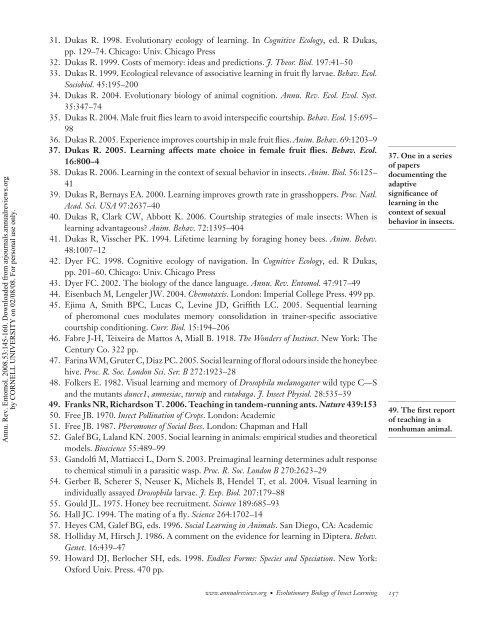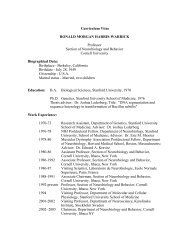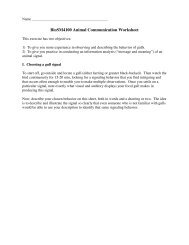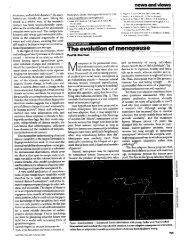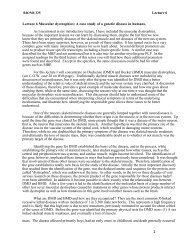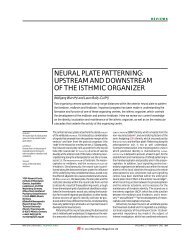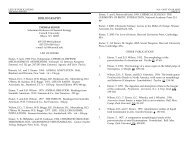Evolutionary Biology of Insect Learning - Department of ...
Evolutionary Biology of Insect Learning - Department of ...
Evolutionary Biology of Insect Learning - Department of ...
Create successful ePaper yourself
Turn your PDF publications into a flip-book with our unique Google optimized e-Paper software.
Annu. Rev. Entomol. 2008.53:145-160. Downloaded from arjournals.annualreviews.orgby CORNELL UNIVERSITY on 02/08/08. For personal use only.31. Dukas R. 1998. <strong>Evolutionary</strong> ecology <strong>of</strong> learning. In Cognitive Ecology, ed. R Dukas,pp. 129–74. Chicago: Univ. Chicago Press32. Dukas R. 1999. Costs <strong>of</strong> memory: ideas and predictions. J. Theor. Biol. 197:41–5033. Dukas R. 1999. Ecological relevance <strong>of</strong> associative learning in fruit fly larvae. Behav. Ecol.Sociobiol. 45:195–20034. Dukas R. 2004. <strong>Evolutionary</strong> biology <strong>of</strong> animal cognition. Annu. Rev. Ecol. Evol. Syst.35:347–7435. Dukas R. 2004. Male fruit flies learn to avoid interspecific courtship. Behav. Ecol. 15:695–9836. Dukas R. 2005. Experience improves courtship in male fruit flies. Anim. Behav. 69:1203–937. Dukas R. 2005. <strong>Learning</strong> affects mate choice in female fruit flies. Behav. Ecol.16:800–438. Dukas R. 2006. <strong>Learning</strong> in the context <strong>of</strong> sexual behavior in insects. Anim. Biol. 56:125–4139. Dukas R, Bernays EA. 2000. <strong>Learning</strong> improves growth rate in grasshoppers. Proc. Natl.Acad. Sci. USA 97:2637–4040. Dukas R, Clark CW, Abbott K. 2006. Courtship strategies <strong>of</strong> male insects: When islearning advantageous? Anim. Behav. 72:1395–40441. Dukas R, Visscher PK. 1994. Lifetime learning by foraging honey bees. Anim. Behav.48:1007–1242. Dyer FC. 1998. Cognitive ecology <strong>of</strong> navigation. In Cognitive Ecology, ed. R Dukas,pp. 201–60. Chicago: Univ. Chicago Press43. Dyer FC. 2002. The biology <strong>of</strong> the dance language. Annu. Rev. Entomol. 47:917–4944. Eisenbach M, Lengeler JW. 2004. Chemotaxis. London: Imperial College Press. 499 pp.45. Ejima A, Smith BPC, Lucas C, Levine JD, Griffith LC. 2005. Sequential learning<strong>of</strong> pheromonal cues modulates memory consolidation in trainer-specific associativecourtship conditioning. Curr. Biol. 15:194–20646. Fabre J-H, Teixeira de Mattos A, Miall B. 1918. The Wonders <strong>of</strong> Instinct. New York: TheCentury Co. 322 pp.47. Farina WM, Gruter C, Diaz PC. 2005. Social learning <strong>of</strong> floral odours inside the honeybeehive. Proc. R. Soc. London Sci. Ser. B 272:1923–2848. Folkers E. 1982. Visual learning and memory <strong>of</strong> Drosophila melanogaster wild type C—Sand the mutants dunce1, amnesiac, turnip and rutabaga. J. <strong>Insect</strong> Physiol. 28:535–3949. Franks NR, Richardson T. 2006. Teaching in tandem-running ants. Nature 439:15350. Free JB. 1970. <strong>Insect</strong> Pollination <strong>of</strong> Crops. London: Academic51. Free JB. 1987. Pheromones <strong>of</strong> Social Bees. London: Chapman and Hall52. Galef BG, Laland KN. 2005. Social learning in animals: empirical studies and theoreticalmodels. Bioscience 55:489–9953. Gandolfi M, Mattiacci L, Dorn S. 2003. Preimaginal learning determines adult responseto chemical stimuli in a parasitic wasp. Proc. R. Soc. London B 270:2623–2954. Gerber B, Scherer S, Neuser K, Michels B, Hendel T, et al. 2004. Visual learning inindividually assayed Drosophila larvae. J. Exp. Biol. 207:179–8855. Gould JL. 1975. Honey bee recruitment. Science 189:685–9356. Hall JC. 1994. The mating <strong>of</strong> a fly. Science 264:1702–1457. Heyes CM, Galef BG, eds. 1996. Social <strong>Learning</strong> in Animals. San Diego, CA: Academic58. Holliday M, Hirsch J. 1986. A comment on the evidence for learning in Diptera. Behav.Genet. 16:439–4759. Howard DJ, Berlocher SH, eds. 1998. Endless Forms: Species and Speciation. New York:Oxford Univ. Press. 470 pp.37. One in a series<strong>of</strong> papersdocumenting theadaptivesignificance <strong>of</strong>learning in thecontext <strong>of</strong> sexualbehavior in insects.49. The first report<strong>of</strong> teaching in anonhuman animal.www.annualreviews.org • <strong>Evolutionary</strong> <strong>Biology</strong> <strong>of</strong> <strong>Insect</strong> <strong>Learning</strong> 157


